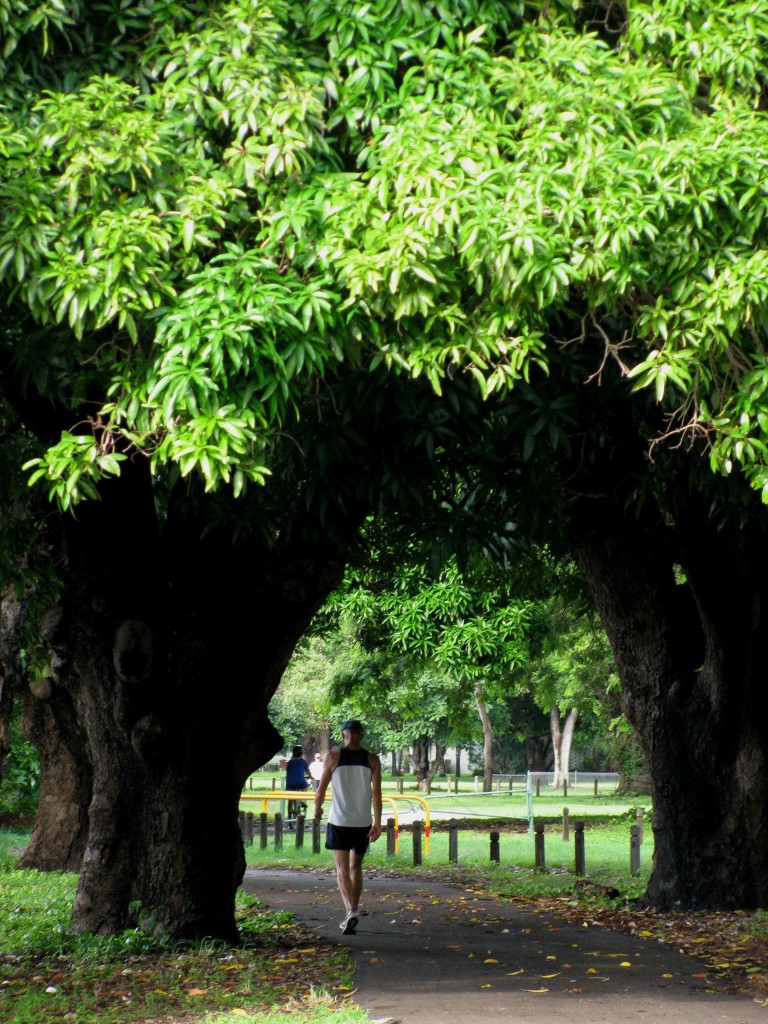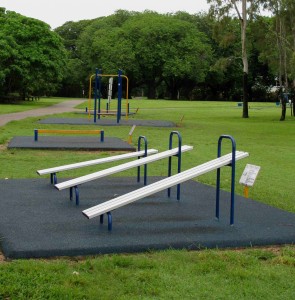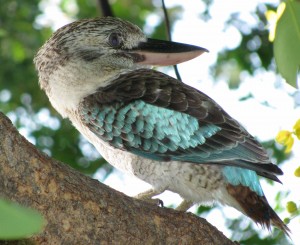
Mango Trees in Ross River Parkway, Townsville (© Magi Nams)
This morning, when I began my running/walking at 5:35 a.m., city street lights still shone and the first cars were arriving at the golf club. I looked for bats flying east after their nightly foray for fruits and nectar, but saw none. Through my reading, I’ve learned that, depending on the distance to their food source, flying foxes may return to their camp at any time during the night, but often return just before dawn, frequently following the same flight path that they flew on their exodus from camp, but in reverse.1
After skirting the golf course, I ran under the Bowen Road bridge and into new territory along the river to the south and west. I could feel my body waking up and becoming accustomed both to regular exercising, which went out the window in the flurry of pre-departure packing and cleaning in Nova Scotia, and to the early morning air of Townsville. A welcome breeze wicked away perspiration, and a mound of dark blue cloud blocked much of the sun from view; the two together granting a respite from the sauna.

Fitness Track, Ross River Parkway, Townsville (© Magi Nams)
I passed a fitness track composed of stations set up with exercise equipment – push-up bars, chin-up bars, inclined sit-up boards, a step-up bar, and so on. An older man utilized a step machine and then moved on to work at a different station, pausing to wipe the sweat from his face with a small, blue towel. A young woman standing in foot holders grasped handle bars with her hands and swung her lower body from side to side. I was impressed by the city’s initiative in providing this free, outdoor fitness centre in the middle of a scenic river park.

Blue-winged Kookaburra (© Magi Nams)
I caught sweet glimpses of birds, too – a kookaburra growling in a tree, its blue wing patch so vivid it looked like glinting reflective tape; a pheasant coucal issuing throaty hisses from within the cover of riverside shrubs, its long, dark tail hanging down and at first causing me to think I’d located a roosting flying fox; white ibises in flight; doves and honeyeaters and figbirds.
Huge mango trees edged the path, their new leaves infused with burgundy, the ground beneath their boughs littered with hairy seed husks. I completed half of my twelve intervals and turned back, observing with interest those with whom I shared this section of parkway path.
The cyclists were primarily muscular young men in spandex shorts, but a grey-haired couple and an elderly, white-haired woman pedaled past me serenely. The lone inline skater was Vilis. The few runners were, surprisingly, in the age bracket of heading for early retirement. One child was out strolling with a woman, but the majority of walkers were middle-aged and up. Many were exercising dogs, most of which were short-coated breeds, which makes sense in this climate. The most interesting of the dogs was a clipped black standard poodle carrying panniers. It pranced along beside a stocky man who strode forth purposefully in his shorts and t-shirt of black and red and wore a broad, black hat. The two together presented a striking pair and, in my mind, hinted at all sorts of things – ‘get ‘er done’ attitude, sharing the burden, a love of grace and colour, loyalty. Maybe I just caught a glimpse of Australia. I ran on, retracing my steps like a flying fox returning to camp.
After supper, Vilis and I returned Richard’s key to Millie and Barry and paused to chat about the impending weather, namely wind and rain headed down the North Queensland coast as fallout from ex Tropical Cyclone Neville. “And there’s another one,” Barry told us, inviting us into his and Millie’s living room to see the display of weather currently on the television. On the screen, we saw a swirling white cloud located in the Coral Sea east of Cape York Peninsula, the triangular spearhead of land at Queensland’s top end that stretches north toward New Guinea. That low pressure system was Olga, which is expected to make landfall south of Cooktown this coming weekend as a Category 2 cyclone with winds of 150 kph.
Townsville has a few hundred kilometres of breathing space from the expected landfall, a fact that made Vilis feel both relief and disappointment. Ever since Lee, the janitor he sees on weekday mornings at James Cook University, told him about her wild experiences during ‘the big one’ in 1971 – Tropical Cyclone Althea – he’s wanted at least the tail end of a cyclone to hit Townsville.
During Althea, which slammed into Magnetic Island and Townsville on Christmas Eve as a Category 4 cyclone packing winds up to 230 kph,2 Lee and her son sat out the maelstrom in a house having wood walls that bulged out and sucked in repeatedly due to the air pressure changes associated with the cyclone. One part of the house split away from the rest, and Lee’s son blacked out from the pressure changes, not waking up until the storm was over. The cyclone caused 3 deaths, over $50 million in damage, and destroyed or damaged 90% of the homes on Magnetic Island.3 “It was really scary,” Lee told Vilis. “But it sure was exciting!”
And so we waited to see whether cyclone fallout would come our way.
References:
1. Leslie Hall and Greg Richards. Flying Foxes: Fruit and Blossom Bats of Australia. 2000. University of New South Wales Press Ltd, Sydney, p. 60.
2. Wikipedia. 1970-75 Southern Hemisphere tropical cyclone seasons. Updated 5-Jun-2010. Accessed 25-Nov-2010. http://en.wikipedia.org/wiki/1970-75_Southern_Hemisphere_tropical_cyclone_seasons
3. Windworker. Queensland Cyclones: Cyclones to have impacted on Queensland, Australia from 1864. Accessed 25-Nov-2010. http://www.windworker.com.au/qldcyclones.htm


